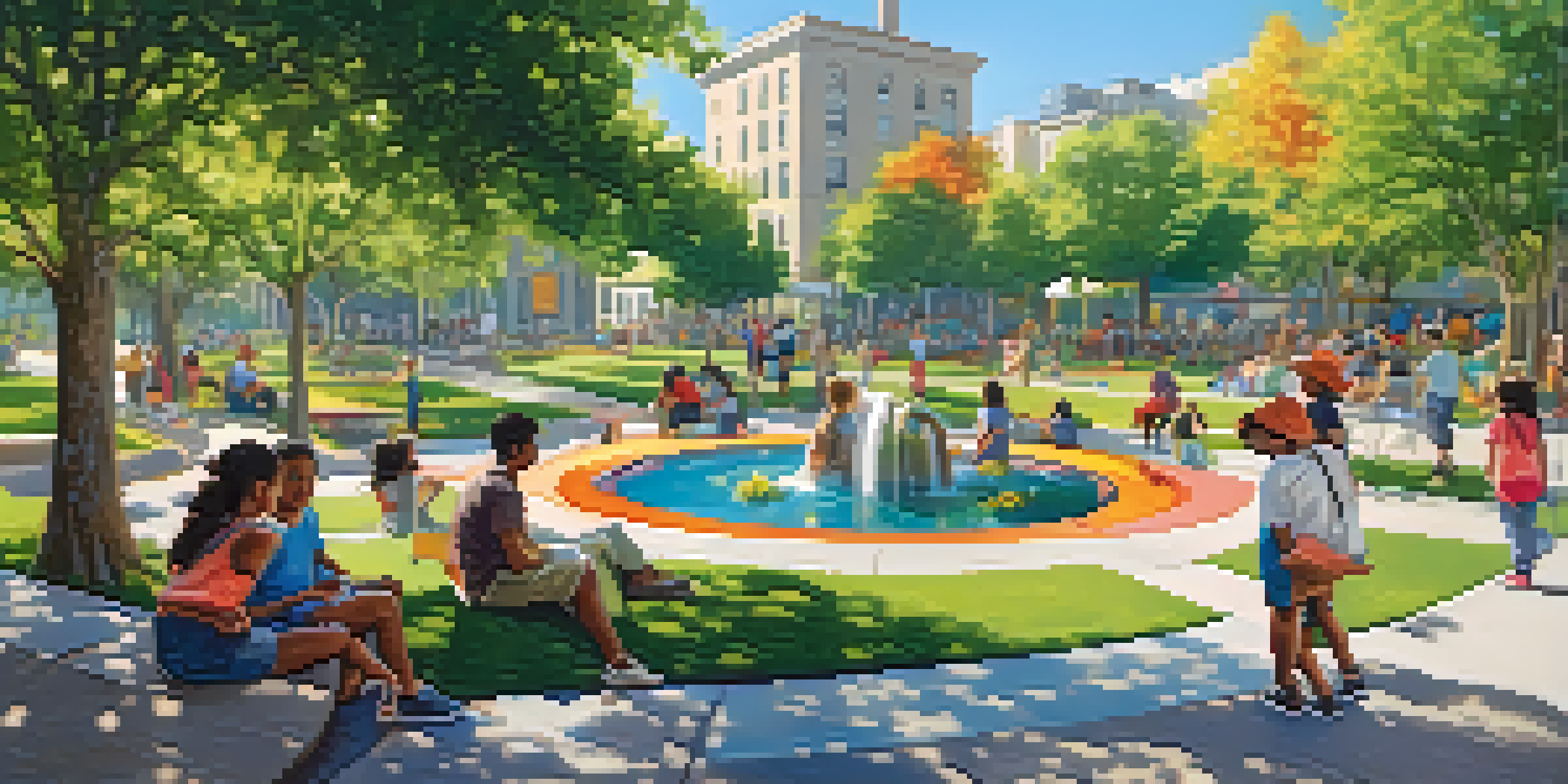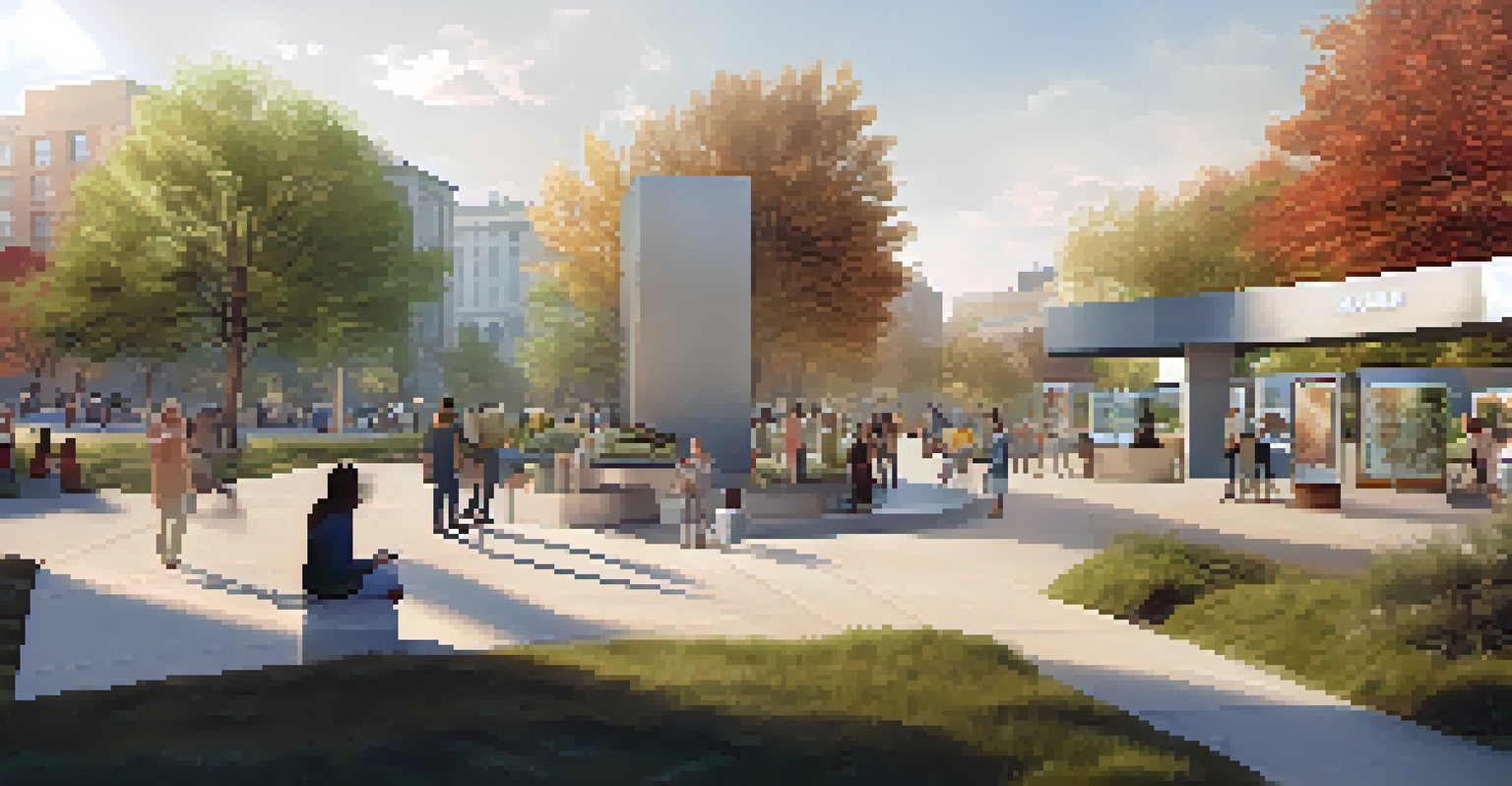Artistic Principles in the Design of Public Spaces

The Importance of Public Spaces in Urban Design
Public spaces serve as the heart of urban environments, providing areas for community interaction and social engagement. They act as a canvas where art, nature, and human activity can blend harmoniously. Through thoughtful design, these spaces can foster a sense of belonging and reflect the cultural identity of a community.
Public spaces are the heart of every community, they are the spaces where we come together, share experiences, and create memories.
Imagine a bustling city square filled with art installations, greenery, and places to sit—this is where life happens. Such spaces encourage people to gather, share stories, and create memories. The role of public spaces extends beyond aesthetics; they are essential for promoting social cohesion and enhancing the quality of urban life.
Moreover, well-designed public spaces can stimulate local economies by attracting visitors and encouraging commerce. Whether it's a park, plaza, or waterfront, these areas invite exploration and leisure, making them invaluable to the fabric of a city.
Understanding Artistic Principles in Design
Artistic principles in design serve as guidelines for creating visually appealing and functional spaces. These principles include balance, contrast, harmony, and rhythm, which help designers craft environments that resonate with users. By applying these concepts, designers can evoke emotions and create experiences that engage the senses.

For instance, balance in design can be seen in the arrangement of elements like seating, pathways, and greenery, ensuring that no area feels overcrowded or neglected. Contrast might be used to highlight key features, such as sculptures against lush gardens, drawing attention and encouraging exploration. Harmony ties everything together, creating a cohesive look that feels inviting.
Public Spaces Foster Community
Well-designed public spaces enhance social interactions and a sense of belonging among community members.
Understanding these principles is essential for designers looking to transform public spaces into vibrant community hubs. When elements work together seamlessly, they create a sense of flow, guiding visitors through the space while allowing them to interact with their surroundings.
Incorporating Nature into Public Space Design
Nature plays a vital role in the design of public spaces, contributing to both aesthetic appeal and environmental sustainability. Integrating greenery, water features, and natural materials can enhance the beauty of an area while providing ecological benefits. Parks and gardens not only beautify urban landscapes but also improve air quality and support biodiversity.
Design is not just what it looks like and feels like. Design is how it works.
Consider the calming effect of trees lining a walkway or the sound of water flowing in a fountain. These elements provide a sensory experience that can make a space feel more welcoming and serene. Nature can also serve as a backdrop for public art, creating dynamic interactions between the natural and built environments.
Moreover, incorporating nature into public spaces encourages physical activity and promotes mental well-being. Spaces designed with ample greenery invite people to engage in outdoor activities like walking, jogging, or simply enjoying a picnic, fostering a healthier lifestyle.
The Role of Art in Enhancing Public Spaces
Art has a transformative power that can breathe life into public spaces, making them more engaging and memorable. From murals to sculptures, artistic installations can tell the story of a community and reflect its values. These artworks often become landmarks that draw visitors and foster a sense of pride among locals.
Imagine walking through a city and encountering a vibrant mural that captures the essence of its culture; such experiences create connections between people and places. Public art can also act as a catalyst for conversation, encouraging discussions about history, identity, and social issues. This interaction enriches the communal experience and deepens the appreciation for the space.
Art Enhances Public Engagement
Art installations in public spaces create memorable experiences and foster connections between people and their environment.
Additionally, art can be used strategically to define areas within a public space, guiding movement and creating focal points. By blending creativity with functionality, designers can craft environments that are not only beautiful but also serve a purpose, making art an essential component of public space design.
Creating Inclusive Public Spaces for All
Inclusivity is a crucial aspect of public space design, ensuring that everyone can access and enjoy these areas. Designers must consider the diverse needs of the community, including individuals of different ages, abilities, and backgrounds. By prioritizing accessibility, public spaces can become welcoming environments for all.
For example, incorporating ramps, wide pathways, and sensory-friendly areas allows individuals with mobility challenges to navigate space comfortably. Additionally, providing seating options and play areas for children fosters interaction between families and encourages community gathering. Inclusivity creates a sense of belonging, making public spaces feel like home.
Ultimately, designing with inclusivity in mind not only benefits individuals but also strengthens the community as a whole. When everyone feels welcome, public spaces can thrive as vibrant hubs of activity, enhancing social connections and enriching the urban experience.
The Impact of Technology on Public Space Design
Technology is revolutionizing the way we design and interact with public spaces. From smart lighting and interactive installations to digital information kiosks, technology can enhance user experiences and improve functionality. Integrating tech solutions into design not only modernizes spaces but also makes them more adaptable to changing needs.
Consider how digital displays can provide real-time information about events or public transportation, enhancing the user experience. Interactive elements, such as augmented reality art installations, invite visitors to engage in new and exciting ways, creating memorable experiences. Technology can also assist in monitoring and maintaining these spaces more efficiently.
Inclusivity is Essential in Design
Creating accessible public spaces ensures that individuals of all ages and abilities can enjoy and participate in community activities.
However, it's essential to balance tech integration with the natural and artistic elements of a space. While technology can enhance functionality, the core design should remain rooted in the principles of beauty and community engagement. By thoughtfully incorporating technology, designers can create public spaces that are not only functional but also innovative.
The Future of Public Space Design
As our cities continue to evolve, the design of public spaces must adapt to meet the changing needs of their communities. Future designs will likely focus on sustainability, technology, and inclusivity, prioritizing the well-being of both people and the planet. This holistic approach will shape public spaces that are not just functional but also enriching and inspiring.
Emerging trends may include the use of eco-friendly materials, green infrastructure, and designs that promote community engagement. Public spaces could become multifunctional, offering areas for recreation, relaxation, and cultural events all in one place. The goal is to create environments that foster social interaction while being mindful of environmental impact.

Ultimately, the future of public space design will be about creating places that reflect the values and needs of the community. By embracing innovation and prioritizing artistic principles, designers can craft spaces that resonate with the public, ensuring they remain vital components of urban life.